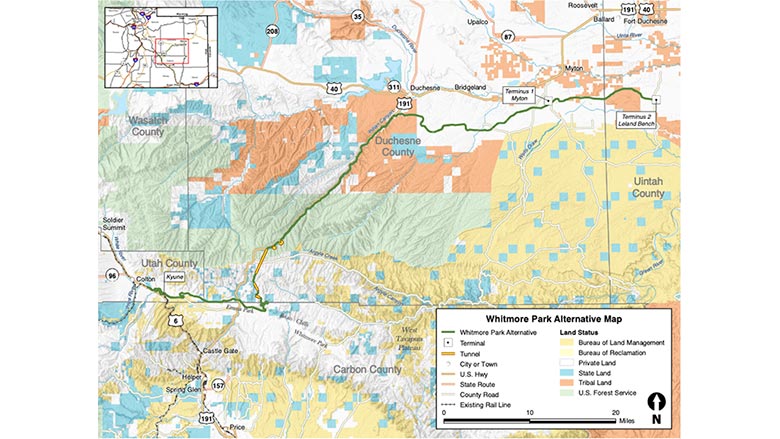Plans for a long-awaited Utah railroad are moving forward as one of the firms involved in the public-private partnership developing the project announced the engineering and construction firms that will work on the $1.35-billion Uinta Basin Railway.
AECOM will deliver the final design other than tunnels for the 88-mile-long railroad, Rio Grande Pacific Corp. announced May 13. A Skanska-WW Clyde joint venture will build the railroad other than tunnels, while Obayashi Corp. will provide final design and construction of the tunnels.
“Numerous qualified and technically proficient engineering and construction firms, including most of the major firms in the U.S., pursued the Uinta Basin Railway project, and provided to us high-quality and creative responses,” Richard Bertel, chairman and CEO of Rio Grande Pacific, said in a statement.
The single-track railroad is planned to serve mineral, energy, agricultural, construction and manufacturing industries in the Uinta Basin, though documents indicate crude oil is the primary anticipated cargo. The railroad will be northeastern Utah's first common-carrier railroad service. Also, it will connect terminus points near Myton and Leland Bench to the national rail network via the Union Pacific Provo Subdivision near Kyune.
The preferred route, known as the Whitmore Park Alternative, will include five tunnels totaling 5.7 miles, 30 rail bridges, one road bridge and 423 culverts. In addition to the single track, there will be nine sidings totaling about 18 miles to allow trains to pass in opposite directions. Plans also call for power lines for signals, communications and safety equipment.
“We’re thrilled to be chosen for the largest new railroad construction project in the U.S. since the 1970s,” Garrett McMullin, area manager for WW Clyde, said in a statement.
The route would cross 12 miles of Ashley National Forest, 8.1 miles of Ute Indian Tribe of the Uintah and Ouray Reservation lands. The federal Surface Transportation Board granted approval for the Whitmore Park Alternative in December 2021, and Rio Grande Pacific says the tribe is an equity partner in the railroad. Ute officials did not immediately return requests for comment.
The concept of a railroad from the Uinta Basin has been explored several times since the 1980s. The Utah Dept. of Transportation undertook another study of the idea in 2015 and, as ENR previously reported, the effort gained momentum when a group of Utah counties allied as the Seven County Infrastructure Coalition entered a public-private partnership with Drexel Hamilton Infrastructure Partners to provide the bulk of the financing and Rio Grande Pacific for design, construction and operations.
Design is expected to continue into next year, according to the coalition. Construction is expected to start in 2024 and last about 28 months.
Once built, documents filed on the project state that a typical train on the railroad would consist of 110 cars pulled by eight locomotives. Depending on the amount of rail traffic needed, the railroad is expected to see an average between 3.68 and 10.52 trains per day.






Post a comment to this article
Report Abusive Comment